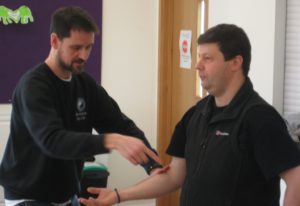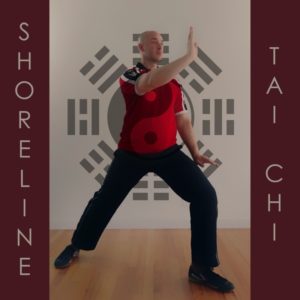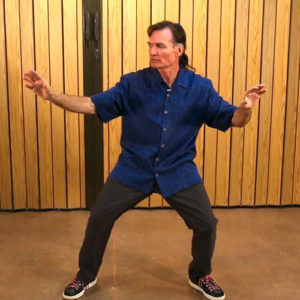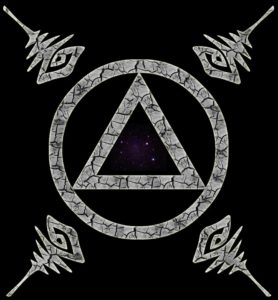Slanted FlyingJournal of Tai Chi Chuan
News
Wounded Warriors, Tai Chi, And Injury Recovery
Master Instructor Norm Gill, who discovered tai chi for himself in 1995, began a class for wounded soldiers at Fort Bragg in 2012. Five years later, the class is still going strong.
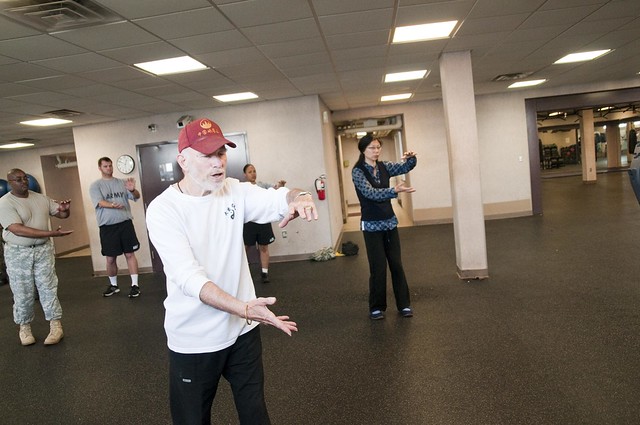 Instructor Norm Gill (in red hat) leads students through Tai Chi movements.
Instructor Norm Gill (in red hat) leads students through Tai Chi movements.
Although most of the students are injured soldiers, the eclectic group also includes foreign liaison officers and those individuals who are interested in the ancient Chinese art form. What makes tai chi special, according to Gill, is that it brings body and mind together and stresses the health of both, which is especially useful for wounded warriors struggling with issues like brain injuries. “They usually are dizzy and have balance issues, and so to work with the breathing and the calming effect it has, it really helps them with their balance,” explained physical therapy assistant Wendi Sheets. The exercises are also ideal for other types of injuries, such as torn rotator cuffs and broken bones, as many practitioners find relief in tai chi when traditional medicine has fallen short. Captain Lloyd Blackburn, who suffers from a variety of injuries, said tai chi helps him find “inner peace” and it is also “a good workout.”
Gill, who is an injured veteran himself, summed up tai chi by saying “It teaches you to know yourself.”
Traditional Recovery vs Tai Chi Recovery
Most people, including both doctors and patients, assume that physical injuries are just physical problems that also have physical corrections, such as a support brace and perhaps some physical therapy. In many cases, that’s a perfectly accurate assessment, because many people quickly respond to these kinds of treatment regimens, especially considering the wide array of choices available. For example, you can read more about the different kinds of advanced hinged knee braces that are suitable for ACL tears and other such wounds.
But a strictly physical response is not always the best approach, because injuries heal much faster when the parasympathetic “rest and digest” nervous system is fully engaged. Such engagement dramatically decreases cortisol levels, and this stress hormone often retards injury recovery.
Of course, tai chi has a physical component as well, and gradual yet somewhat rigorous exercise is one of the best ways to rehabilitate an injured body part.
Tai Chi Benefits
As several of the wounded warriors noted, tai chi’s gentle and gradual movements are suitable for everyone, almost regardless of age, weight, and general health. This dynamic is important for injury recovery, because when the body’s resources are geared towards healing an injury, strenuous physical exercise is much more difficult. ower movements are especially ideal for joint injuries and other wounds that usually only get better through movement, but even a little too much movement can be devastating.
In summary, for many people, tai chi is the happy medium between aggressive physical therapy and a sedentary lifestyle.
Along this same line, tai chi is far away from the “give 110 percent” mentality that’s so pervasive in the West. Because most practitioners perform their exercises at about 70 or 80 percent, the soft tissues are more relaxed, so there is almost no chance of injury aggravation. That effort level also helps the injured area heal gently and naturally while keeping the rest of the body stronger.
Blood flow is one of the most important elements in the injury recovery realm, and tai chi gets the blood flowing perhaps better than any other kind of exercise, even yoga. Especially in the immediate aftermath of a serious injury, almost any movement is very painful, and that immobility is one of the biggest obstacles to speedy recovery.
Tai chi’s gradual movements slightly elevate the heart rate and move body parts to also move blood. Yet the effect is so subtle that there is no shock to the system.
Even more importantly, tai chi is relaxing, so it unleashes the parasympathetic nervous system, as mentioned above. Muscle tension saps our energy and triggers stress, pulling us into a downward spiral just as we need positive energy to help us heal. Tai chi reverses this process, by stressing slow, easy movements, correct breathing, upright posture, and mental placidity.
The relaxation also strengthens uninjured areas of the body, and sometimes, the best path to recovery is to make our strong areas even stronger.
Many doctors and therapists note that a large number of patients assume almost no role in their injury recoveries, instead relying on devices and pills to do all the work. From this perspective, tai chi is also very empowering for injured patients, and that may be the most effective injury recovery method of them all.



